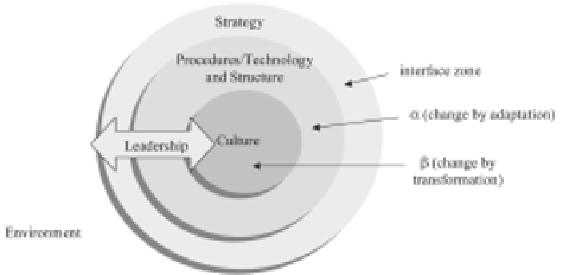Information Technology Reference
In-Depth Information
and effort, to change organisational culture and the political network as well (Svyantek
and DeShon, 1993), as illustrated in Figure 11.8.
Figure 11.8. System interface and hierarchy of efforts required for change in
an organisation.
In order for an organisation to operate successfully in a specific environment, it needs
an interface between its subsystems and the environment. Organisational strategy is
such an interface (Cavaleri and Obloj, 1993). The next layer (
α
layer) is the zone in which
the interplay between technology, process and structure to carry out the organisation's
operations exists and is active. Variables and factors in this zone are more sensitive to
the disturbance from both internal and external sources and less difficult to manage and
change than those from the inner core (or
β
zone). This ensemble of variables can be
changed, with a certain effort, to achieve a proper alignment with the environment - a
process called adaptation. Figure 11.8 also shows that all elements in both the
α
and
β
zones are exposed to the environment although the degree of exposure may vary (e.g.
the production line is shielded from fluctuations in demand and supply to a certain ex-
tent). Lastly, the core of this diagram (or
β
zone) represents organisational culture, an
element that is very influential for the survival and performance of the organisation
(Peters and Waterman, 1982; Handy, 1995, 1999; Hofstede, 1997). The impact of culture
on organisations is pervasive because it controls people's beliefs and shared values, and
it is also transferable from one generation to the next. It is thus unlikely that culture
can easily be changed or adjusted to conform to the changing environment. It requires
a great deal of energy, effort and time to change the existing culture, and this is beyond
the adaptive mechanism (Svyantek and DeShon, 1993). That is why we call a change at
a cultural level a 'deep change.' As a consequence, it is proposed in this model that only
transformation as a means of systemic change can have a profound effect on the organ-
isation's culture.
As far as change is concerned, leadership is an essential factor in influencing change in
other variables or factors. In Figure 11.8, leadership provides a linkage between the
external environment, strategy and internal factors in both the
α
and
β
zones, and is also
a source of power and authority required to effect change at various levels. Tushman
and Romaneli (1985) assert that strong leadership is essential, especially for the reorient-
ation or transformational phase of change, because not only must a clear vision be de-
clared and communicated to organisational members, but also adequate power and au-
thority is required to alter dysfunctional political networks and overcome resistance to
change. Without strong leadership, it is unlikely that change can be implemented suc-
cessfully in the organisation.

Search WWH ::

Custom Search